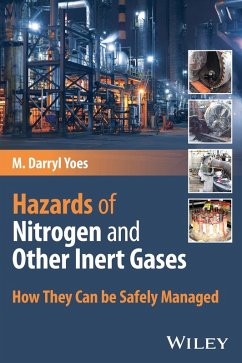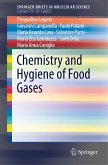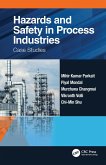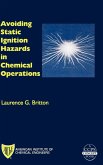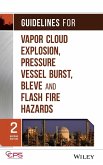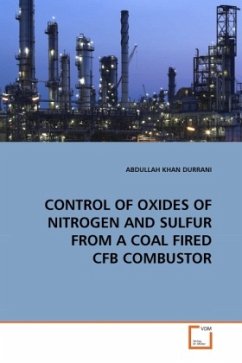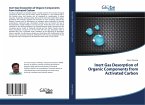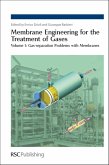- Gebundenes Buch
- Merkliste
- Auf die Merkliste
- Bewerten Bewerten
- Teilen
- Produkt teilen
- Produkterinnerung
- Produkterinnerung
An authoritative discussion of safety considerations for professionals and Operators working with or around nitrogen and other inert gases In Hazards of Nitrogen and Other Inert Gases: How They Can Be Safely Managed, experienced refinery supervisor and manager M. Darryl Yoes delivers a thorough discussion of the use of nitrogen and other inert gases in the refining industry and other industries where they are commonly used. The author includes a complete exploration of the hazards of working with and around nitrogen, as well as case studies of incidents involving nitrogen in both gas and…mehr
Andere Kunden interessierten sich auch für
![Chemistry and Hygiene of Food Gases Chemistry and Hygiene of Food Gases]() Pasqualina LaganàChemistry and Hygiene of Food Gases42,99 €
Pasqualina LaganàChemistry and Hygiene of Food Gases42,99 €![Hazards and Safety in Process Industries Hazards and Safety in Process Industries]() Mihir Kumar PurkaitHazards and Safety in Process Industries205,99 €
Mihir Kumar PurkaitHazards and Safety in Process Industries205,99 €![Avoiding Static Ignition Hazards in Chemical Operations Avoiding Static Ignition Hazards in Chemical Operations]() Laurence G BrittonAvoiding Static Ignition Hazards in Chemical Operations197,99 €
Laurence G BrittonAvoiding Static Ignition Hazards in Chemical Operations197,99 €![Guidelines for Vapor Cloud Explosion, Pressure Vessel Burst, Bleve, and Flash Fire Hazards Guidelines for Vapor Cloud Explosion, Pressure Vessel Burst, Bleve, and Flash Fire Hazards]() Center for Chemical Process Safety (CCPS)Guidelines for Vapor Cloud Explosion, Pressure Vessel Burst, Bleve, and Flash Fire Hazards183,99 €
Center for Chemical Process Safety (CCPS)Guidelines for Vapor Cloud Explosion, Pressure Vessel Burst, Bleve, and Flash Fire Hazards183,99 €![CONTROL OF OXIDES OF NITROGEN AND SULFUR FROM A COAL FIRED CFB COMBUSTOR CONTROL OF OXIDES OF NITROGEN AND SULFUR FROM A COAL FIRED CFB COMBUSTOR]() ABDULLAH KHAN DURRANICONTROL OF OXIDES OF NITROGEN AND SULFUR FROM A COAL FIRED CFB COMBUSTOR56,99 €
ABDULLAH KHAN DURRANICONTROL OF OXIDES OF NITROGEN AND SULFUR FROM A COAL FIRED CFB COMBUSTOR56,99 €![Inert Gas Desorption of Organic Components from Activated Carbon Inert Gas Desorption of Organic Components from Activated Carbon]() Umer FarooqInert Gas Desorption of Organic Components from Activated Carbon35,99 €
Umer FarooqInert Gas Desorption of Organic Components from Activated Carbon35,99 €![Membrane Engineering for the Treatment of Gases Membrane Engineering for the Treatment of Gases]() Membrane Engineering for the Treatment of Gases185,99 €
Membrane Engineering for the Treatment of Gases185,99 €-
-
-
An authoritative discussion of safety considerations for professionals and Operators working with or around nitrogen and other inert gases In Hazards of Nitrogen and Other Inert Gases: How They Can Be Safely Managed, experienced refinery supervisor and manager M. Darryl Yoes delivers a thorough discussion of the use of nitrogen and other inert gases in the refining industry and other industries where they are commonly used. The author includes a complete exploration of the hazards of working with and around nitrogen, as well as case studies of incidents involving nitrogen in both gas and cryogenic forms, and other inert gases, including carbon dioxide, argon, and neon. Yoes walks readers through the most critical safety aspects of working with asphyxiants such as inert confined space entry and discusses how to avoid and prevent catastrophic incidents. The book offers self-quizzes, essential terms, key workflows, and checklists for routine practice. Readers will also find: * A thorough background on nitrogen use and the hazards that flow from working with it * Comprehensive explorations of incidents involving asphyxiation, hypoxia, and cold burns resulting from nitrogen (gas and liquid form) and other inert gases * Practical discussions of the prevention of catastrophic incidents involving inert gases * Additional discussions of other inert gases, including carbon dioxide and helium Perfect for all operations personnel who work with or around asphyxiants, including petroleum refining and petrochemical plant operators, line supervisors, and process and mechanical engineers, this book will also benefit new operators and advanced students learning about or working with nitrogen and other inert gases.
Hinweis: Dieser Artikel kann nur an eine deutsche Lieferadresse ausgeliefert werden.
Hinweis: Dieser Artikel kann nur an eine deutsche Lieferadresse ausgeliefert werden.
Produktdetails
- Produktdetails
- Verlag: Wiley
- Seitenzahl: 272
- Erscheinungstermin: 29. April 2025
- Englisch
- ISBN-13: 9781394330263
- ISBN-10: 139433026X
- Artikelnr.: 72551678
- Herstellerkennzeichnung
- Libri GmbH
- Europaallee 1
- 36244 Bad Hersfeld
- gpsr@libri.de
- Verlag: Wiley
- Seitenzahl: 272
- Erscheinungstermin: 29. April 2025
- Englisch
- ISBN-13: 9781394330263
- ISBN-10: 139433026X
- Artikelnr.: 72551678
- Herstellerkennzeichnung
- Libri GmbH
- Europaallee 1
- 36244 Bad Hersfeld
- gpsr@libri.de
M. Darryl Yoes is an experienced refinery supervisor and manager with over fifty years' experience in the industry. He is a process safety management consultant for refining and petrochemical plants, as well as a construction safety management consultant for major construction projects around the US.
Table of Contents
Preface
About the Author
Chapter 1: The Properties, Uses, and Safety Hazards of Nitrogen.
Chapter 2: The Properties, Uses, and Safety Hazards of Other Inert Gases:
a: Argon (Ar)
b: Carbon Dioxide (CO2)
c: Carbon Monoxide (CO)
d: Helium (He)
e: Neon (Ne)
f: Krypton (Kr)
g: Xenon (Xe)
h: Light Hydrocarbons (Methane (CH-4), Ethane (CH-6), Propane (CH-8),
Butane (CH-10), Pentane (CH-12), and their olefin cousins (Ethylene,
Propylene, Butylene, etc.)
Note:
Hydrocarbons are NOT inert and are flammable or explosive. They are
included here since some of the effects on personnel are similar.
Chapter 3: The Effects of Nitrogen and Other Inert Gases on the Human Body
(Oxygen Deprivation and Hypoxia).
Chapter 4: Protection for Personnel Against Inert Gas Asphyxiation and/or
Cold Burns.
Chapter 5: Confined Space Entry - The Occupational Safety and Health
Administration (OSHA) Standard (29 CFR 1910.146), and Some Key OSHA
"Letters of Interpretation".
Chapter 6: The Hazard of Contaminated Breathing Air and How it Can Kill.
Chapter 7: The Most Frequent Causes of Nitrogen Asphyxiation and How to
Address Them.
Chapter 8: More on Safe Utility Connections.
Chapter 9: The Hazards of Inert Entry and an Overview of the Process
(Includes Case Studies of What Has Happened).
Chapter 10: Carbon Capture, Use and Storage (CCUS)
Chapter 11: Nitrogen Asphyxiation Case Studies, Including Case Studies of
Asphyxiation by Other Inert Gases:
a: Incident Case Study Number 1:
Liquid Nitrogen Release at Foundation Food Group (6 Fatalities, 4 serious
Injuries).
The incident occurred in Gainesville, Georgia - Incident Date: January 28,
2021
b:Incident Case Study Number 2:
Fatal Nitrogen Exposure at Valero Delaware City Refinery (2 Fatalities).
The incident occurred in Delaware City, Delaware - Incident Date: November
5, 2005
c:Incident Case Study Number 3:
Alaska North Slope Oil-Service Company
Fatal Argon Exposure During Welding Operations (1 Fatality, 2 Injuries).
The incident occurred at The North Slope of Alaska - Incident Date: April
29, 1994
d:Incident Case Study Number 4:
Fatal Argon Exposure in Asia during Pipe Welding Operations (1 Fatality).
The incident occurred at a Singapore worksite during
construction/modifications - Incident Date: November 24, 2020
e.Incident Case Study Number 5:
Carbon Dioxide Asphyxiation at a Music and Performing Arts Theatre (1
Fatality).
The incident occurred at Pigeon Forge, Tennessee - Incident Date: March 3,
2018
f.Incident Case Study Number 6:
An employer's failure to follow federal safety procedures left a
30-year-old worker suffering fatal asphyxiation as they tried to make
repairs inside a water tank at a McClain County well site in September
2023. Following the incident, investigators found several asphyxiants in
the tank, resulting in the employee's death.
g.Incident Case Study Number 7:
The employee had been pressure testing a section of piping with nitrogen
and was overcome by the inert gas. His coworkers, who had left him the
previous evening, found him the following morning.
h.Incident Case Study Number 8:
An explosion occurred while Liquid nitrogen was unloaded at an ice cream
facility (ten injured).¿
i.Incident Case Study Number 9 Fatality of Welder in a Confined Space
(Welding in the Presence of Argon)
A contract welder was overcome and died due to the lack of oxygen while
troubleshooting an argon dam in a 30-inch section of piping. The incident
occurred on September 15, 2021.
j.Incident Case Study Number 10 (Deaths due to Attempted Rescue):
This case study includes several additional brief reports of asphyxiation
incidents involving inert gas.
This includes a review of seven (7) different incidents resulting in
sixteen (16) deaths and several injuries. These brief reports discuss the
causal factors involved in each incident and key lessons learned. As you
may expect, there are a number of parallels involved in the lessons
learned.
Chapter 12: Summary of Additional Actions to Help Prevent Asphyxiation
Incidents at our Facilities:
Chapter 13: Additional Discussion of Liquid Nitrogen Use in Ice Cream
Shops:
End of Book Quiz
Appendices:
1:Answers to the End of Chapter Quizzes.
2:Answers to the End of Book Quiz.
3:Summary of US Occupational Safety and Health Administration (OSHA)
Nitrogen Asphyxiation Incidents (From the OSHA Database)
Table of Contents
Preface
About the Author
Chapter 1: The Properties, Uses, and Safety Hazards of Nitrogen.
Chapter 2: The Properties, Uses, and Safety Hazards of Other Inert Gases:
a: Argon (Ar)
b: Carbon Dioxide (CO2)
c: Carbon Monoxide (CO)
d: Helium (He)
e: Neon (Ne)
f: Krypton (Kr)
g: Xenon (Xe)
h: Light Hydrocarbons (Methane (CH-4), Ethane (CH-6), Propane (CH-8),
Butane (CH-10), Pentane (CH-12), and their olefin cousins (Ethylene,
Propylene, Butylene, etc.)
Note:
Hydrocarbons are NOT inert and are flammable or explosive. They are
included here since some of the effects on personnel are similar.
Chapter 3: The Effects of Nitrogen and Other Inert Gases on the Human Body
(Oxygen Deprivation and Hypoxia).
Chapter 4: Protection for Personnel Against Inert Gas Asphyxiation and/or
Cold Burns.
Chapter 5: Confined Space Entry - The Occupational Safety and Health
Administration (OSHA) Standard (29 CFR 1910.146), and Some Key OSHA
"Letters of Interpretation".
Chapter 6: The Hazard of Contaminated Breathing Air and How it Can Kill.
Chapter 7: The Most Frequent Causes of Nitrogen Asphyxiation and How to
Address Them.
Chapter 8: More on Safe Utility Connections.
Chapter 9: The Hazards of Inert Entry and an Overview of the Process
(Includes Case Studies of What Has Happened).
Chapter 10: Carbon Capture, Use and Storage (CCUS)
Chapter 11: Nitrogen Asphyxiation Case Studies, Including Case Studies of
Asphyxiation by Other Inert Gases:
a: Incident Case Study Number 1:
Liquid Nitrogen Release at Foundation Food Group (6 Fatalities, 4 serious
Injuries).
The incident occurred in Gainesville, Georgia - Incident Date: January 28,
2021
b: Incident Case Study Number 2:
Fatal Nitrogen Exposure at Valero Delaware City Refinery (2 Fatalities).
The incident occurred in Delaware City, Delaware - Incident Date: November
5, 2005
c: Incident Case Study Number 3:
Alaska North Slope Oil-Service Company
Fatal Argon Exposure During Welding Operations (1 Fatality, 2 Injuries).
The incident occurred at The North Slope of Alaska - Incident Date: April
29, 1994
d: Incident Case Study Number 4:
Fatal Argon Exposure in Asia during Pipe Welding Operations (1 Fatality).
The incident occurred at a Singapore worksite during
construction/modifications - Incident Date: November 24, 2020
e. Incident Case Study Number 5:
Carbon Dioxide Asphyxiation at a Music and Performing Arts Theatre (1
Fatality).
The incident occurred at Pigeon Forge, Tennessee - Incident Date: March 3,
2018
f. Incident Case Study Number 6:
An employer's failure to follow federal safety procedures left a
30-year-old worker suffering fatal asphyxiation as they tried to make
repairs inside a water tank at a McClain County well site in September
2023. Following the incident, investigators found several asphyxiants in
the tank, resulting in the employee's death.
g. Incident Case Study Number 7:
The employee had been pressure testing a section of piping with nitrogen
and was overcome by the inert gas. His coworkers, who had left him the
previous evening, found him the following morning.
h. Incident Case Study Number 8:
An explosion occurred while Liquid nitrogen was unloaded at an ice cream
facility (ten injured).
i. Incident Case Study Number 9 Fatality of Welder in a Confined Space
(Welding in the Presence of Argon)
A contract welder was overcome and died due to the lack of oxygen while
troubleshooting an argon dam in a 30-inch section of piping. The incident
occurred on September 15, 2021.
j. Incident Case Study Number 10 (Deaths due to Attempted Rescue):
This case study includes several additional brief reports of asphyxiation
incidents involving inert gas.
This includes a review of seven (7) different incidents resulting in
sixteen (16) deaths and several injuries. These brief reports discuss the
causal factors involved in each incident and key lessons learned. As you
may expect, there are a number of parallels involved in the lessons
learned.
Chapter 12: Summary of Additional Actions to Help Prevent Asphyxiation
Incidents at our Facilities:
Chapter 13: Additional Discussion of Liquid Nitrogen Use in Ice Cream
Shops:
End of Book Quiz
Appendices:
1: Answers to the End of Chapter Quizzes.
2: Answers to the End of Book Quiz.
3: Summary of US Occupational Safety and Health Administration (OSHA)
Nitrogen Asphyxiation Incidents (From the OSHA Database)
Preface
About the Author
Chapter 1: The Properties, Uses, and Safety Hazards of Nitrogen.
Chapter 2: The Properties, Uses, and Safety Hazards of Other Inert Gases:
a: Argon (Ar)
b: Carbon Dioxide (CO2)
c: Carbon Monoxide (CO)
d: Helium (He)
e: Neon (Ne)
f: Krypton (Kr)
g: Xenon (Xe)
h: Light Hydrocarbons (Methane (CH-4), Ethane (CH-6), Propane (CH-8),
Butane (CH-10), Pentane (CH-12), and their olefin cousins (Ethylene,
Propylene, Butylene, etc.)
Note:
Hydrocarbons are NOT inert and are flammable or explosive. They are
included here since some of the effects on personnel are similar.
Chapter 3: The Effects of Nitrogen and Other Inert Gases on the Human Body
(Oxygen Deprivation and Hypoxia).
Chapter 4: Protection for Personnel Against Inert Gas Asphyxiation and/or
Cold Burns.
Chapter 5: Confined Space Entry - The Occupational Safety and Health
Administration (OSHA) Standard (29 CFR 1910.146), and Some Key OSHA
"Letters of Interpretation".
Chapter 6: The Hazard of Contaminated Breathing Air and How it Can Kill.
Chapter 7: The Most Frequent Causes of Nitrogen Asphyxiation and How to
Address Them.
Chapter 8: More on Safe Utility Connections.
Chapter 9: The Hazards of Inert Entry and an Overview of the Process
(Includes Case Studies of What Has Happened).
Chapter 10: Carbon Capture, Use and Storage (CCUS)
Chapter 11: Nitrogen Asphyxiation Case Studies, Including Case Studies of
Asphyxiation by Other Inert Gases:
a: Incident Case Study Number 1:
Liquid Nitrogen Release at Foundation Food Group (6 Fatalities, 4 serious
Injuries).
The incident occurred in Gainesville, Georgia - Incident Date: January 28,
2021
b:Incident Case Study Number 2:
Fatal Nitrogen Exposure at Valero Delaware City Refinery (2 Fatalities).
The incident occurred in Delaware City, Delaware - Incident Date: November
5, 2005
c:Incident Case Study Number 3:
Alaska North Slope Oil-Service Company
Fatal Argon Exposure During Welding Operations (1 Fatality, 2 Injuries).
The incident occurred at The North Slope of Alaska - Incident Date: April
29, 1994
d:Incident Case Study Number 4:
Fatal Argon Exposure in Asia during Pipe Welding Operations (1 Fatality).
The incident occurred at a Singapore worksite during
construction/modifications - Incident Date: November 24, 2020
e.Incident Case Study Number 5:
Carbon Dioxide Asphyxiation at a Music and Performing Arts Theatre (1
Fatality).
The incident occurred at Pigeon Forge, Tennessee - Incident Date: March 3,
2018
f.Incident Case Study Number 6:
An employer's failure to follow federal safety procedures left a
30-year-old worker suffering fatal asphyxiation as they tried to make
repairs inside a water tank at a McClain County well site in September
2023. Following the incident, investigators found several asphyxiants in
the tank, resulting in the employee's death.
g.Incident Case Study Number 7:
The employee had been pressure testing a section of piping with nitrogen
and was overcome by the inert gas. His coworkers, who had left him the
previous evening, found him the following morning.
h.Incident Case Study Number 8:
An explosion occurred while Liquid nitrogen was unloaded at an ice cream
facility (ten injured).¿
i.Incident Case Study Number 9 Fatality of Welder in a Confined Space
(Welding in the Presence of Argon)
A contract welder was overcome and died due to the lack of oxygen while
troubleshooting an argon dam in a 30-inch section of piping. The incident
occurred on September 15, 2021.
j.Incident Case Study Number 10 (Deaths due to Attempted Rescue):
This case study includes several additional brief reports of asphyxiation
incidents involving inert gas.
This includes a review of seven (7) different incidents resulting in
sixteen (16) deaths and several injuries. These brief reports discuss the
causal factors involved in each incident and key lessons learned. As you
may expect, there are a number of parallels involved in the lessons
learned.
Chapter 12: Summary of Additional Actions to Help Prevent Asphyxiation
Incidents at our Facilities:
Chapter 13: Additional Discussion of Liquid Nitrogen Use in Ice Cream
Shops:
End of Book Quiz
Appendices:
1:Answers to the End of Chapter Quizzes.
2:Answers to the End of Book Quiz.
3:Summary of US Occupational Safety and Health Administration (OSHA)
Nitrogen Asphyxiation Incidents (From the OSHA Database)
Table of Contents
Preface
About the Author
Chapter 1: The Properties, Uses, and Safety Hazards of Nitrogen.
Chapter 2: The Properties, Uses, and Safety Hazards of Other Inert Gases:
a: Argon (Ar)
b: Carbon Dioxide (CO2)
c: Carbon Monoxide (CO)
d: Helium (He)
e: Neon (Ne)
f: Krypton (Kr)
g: Xenon (Xe)
h: Light Hydrocarbons (Methane (CH-4), Ethane (CH-6), Propane (CH-8),
Butane (CH-10), Pentane (CH-12), and their olefin cousins (Ethylene,
Propylene, Butylene, etc.)
Note:
Hydrocarbons are NOT inert and are flammable or explosive. They are
included here since some of the effects on personnel are similar.
Chapter 3: The Effects of Nitrogen and Other Inert Gases on the Human Body
(Oxygen Deprivation and Hypoxia).
Chapter 4: Protection for Personnel Against Inert Gas Asphyxiation and/or
Cold Burns.
Chapter 5: Confined Space Entry - The Occupational Safety and Health
Administration (OSHA) Standard (29 CFR 1910.146), and Some Key OSHA
"Letters of Interpretation".
Chapter 6: The Hazard of Contaminated Breathing Air and How it Can Kill.
Chapter 7: The Most Frequent Causes of Nitrogen Asphyxiation and How to
Address Them.
Chapter 8: More on Safe Utility Connections.
Chapter 9: The Hazards of Inert Entry and an Overview of the Process
(Includes Case Studies of What Has Happened).
Chapter 10: Carbon Capture, Use and Storage (CCUS)
Chapter 11: Nitrogen Asphyxiation Case Studies, Including Case Studies of
Asphyxiation by Other Inert Gases:
a: Incident Case Study Number 1:
Liquid Nitrogen Release at Foundation Food Group (6 Fatalities, 4 serious
Injuries).
The incident occurred in Gainesville, Georgia - Incident Date: January 28,
2021
b: Incident Case Study Number 2:
Fatal Nitrogen Exposure at Valero Delaware City Refinery (2 Fatalities).
The incident occurred in Delaware City, Delaware - Incident Date: November
5, 2005
c: Incident Case Study Number 3:
Alaska North Slope Oil-Service Company
Fatal Argon Exposure During Welding Operations (1 Fatality, 2 Injuries).
The incident occurred at The North Slope of Alaska - Incident Date: April
29, 1994
d: Incident Case Study Number 4:
Fatal Argon Exposure in Asia during Pipe Welding Operations (1 Fatality).
The incident occurred at a Singapore worksite during
construction/modifications - Incident Date: November 24, 2020
e. Incident Case Study Number 5:
Carbon Dioxide Asphyxiation at a Music and Performing Arts Theatre (1
Fatality).
The incident occurred at Pigeon Forge, Tennessee - Incident Date: March 3,
2018
f. Incident Case Study Number 6:
An employer's failure to follow federal safety procedures left a
30-year-old worker suffering fatal asphyxiation as they tried to make
repairs inside a water tank at a McClain County well site in September
2023. Following the incident, investigators found several asphyxiants in
the tank, resulting in the employee's death.
g. Incident Case Study Number 7:
The employee had been pressure testing a section of piping with nitrogen
and was overcome by the inert gas. His coworkers, who had left him the
previous evening, found him the following morning.
h. Incident Case Study Number 8:
An explosion occurred while Liquid nitrogen was unloaded at an ice cream
facility (ten injured).
i. Incident Case Study Number 9 Fatality of Welder in a Confined Space
(Welding in the Presence of Argon)
A contract welder was overcome and died due to the lack of oxygen while
troubleshooting an argon dam in a 30-inch section of piping. The incident
occurred on September 15, 2021.
j. Incident Case Study Number 10 (Deaths due to Attempted Rescue):
This case study includes several additional brief reports of asphyxiation
incidents involving inert gas.
This includes a review of seven (7) different incidents resulting in
sixteen (16) deaths and several injuries. These brief reports discuss the
causal factors involved in each incident and key lessons learned. As you
may expect, there are a number of parallels involved in the lessons
learned.
Chapter 12: Summary of Additional Actions to Help Prevent Asphyxiation
Incidents at our Facilities:
Chapter 13: Additional Discussion of Liquid Nitrogen Use in Ice Cream
Shops:
End of Book Quiz
Appendices:
1: Answers to the End of Chapter Quizzes.
2: Answers to the End of Book Quiz.
3: Summary of US Occupational Safety and Health Administration (OSHA)
Nitrogen Asphyxiation Incidents (From the OSHA Database)
Table of Contents
Preface
About the Author
Chapter 1: The Properties, Uses, and Safety Hazards of Nitrogen.
Chapter 2: The Properties, Uses, and Safety Hazards of Other Inert Gases:
a: Argon (Ar)
b: Carbon Dioxide (CO2)
c: Carbon Monoxide (CO)
d: Helium (He)
e: Neon (Ne)
f: Krypton (Kr)
g: Xenon (Xe)
h: Light Hydrocarbons (Methane (CH-4), Ethane (CH-6), Propane (CH-8),
Butane (CH-10), Pentane (CH-12), and their olefin cousins (Ethylene,
Propylene, Butylene, etc.)
Note:
Hydrocarbons are NOT inert and are flammable or explosive. They are
included here since some of the effects on personnel are similar.
Chapter 3: The Effects of Nitrogen and Other Inert Gases on the Human Body
(Oxygen Deprivation and Hypoxia).
Chapter 4: Protection for Personnel Against Inert Gas Asphyxiation and/or
Cold Burns.
Chapter 5: Confined Space Entry - The Occupational Safety and Health
Administration (OSHA) Standard (29 CFR 1910.146), and Some Key OSHA
"Letters of Interpretation".
Chapter 6: The Hazard of Contaminated Breathing Air and How it Can Kill.
Chapter 7: The Most Frequent Causes of Nitrogen Asphyxiation and How to
Address Them.
Chapter 8: More on Safe Utility Connections.
Chapter 9: The Hazards of Inert Entry and an Overview of the Process
(Includes Case Studies of What Has Happened).
Chapter 10: Carbon Capture, Use and Storage (CCUS)
Chapter 11: Nitrogen Asphyxiation Case Studies, Including Case Studies of
Asphyxiation by Other Inert Gases:
a: Incident Case Study Number 1:
Liquid Nitrogen Release at Foundation Food Group (6 Fatalities, 4 serious
Injuries).
The incident occurred in Gainesville, Georgia - Incident Date: January 28,
2021
b:Incident Case Study Number 2:
Fatal Nitrogen Exposure at Valero Delaware City Refinery (2 Fatalities).
The incident occurred in Delaware City, Delaware - Incident Date: November
5, 2005
c:Incident Case Study Number 3:
Alaska North Slope Oil-Service Company
Fatal Argon Exposure During Welding Operations (1 Fatality, 2 Injuries).
The incident occurred at The North Slope of Alaska - Incident Date: April
29, 1994
d:Incident Case Study Number 4:
Fatal Argon Exposure in Asia during Pipe Welding Operations (1 Fatality).
The incident occurred at a Singapore worksite during
construction/modifications - Incident Date: November 24, 2020
e.Incident Case Study Number 5:
Carbon Dioxide Asphyxiation at a Music and Performing Arts Theatre (1
Fatality).
The incident occurred at Pigeon Forge, Tennessee - Incident Date: March 3,
2018
f.Incident Case Study Number 6:
An employer's failure to follow federal safety procedures left a
30-year-old worker suffering fatal asphyxiation as they tried to make
repairs inside a water tank at a McClain County well site in September
2023. Following the incident, investigators found several asphyxiants in
the tank, resulting in the employee's death.
g.Incident Case Study Number 7:
The employee had been pressure testing a section of piping with nitrogen
and was overcome by the inert gas. His coworkers, who had left him the
previous evening, found him the following morning.
h.Incident Case Study Number 8:
An explosion occurred while Liquid nitrogen was unloaded at an ice cream
facility (ten injured).¿
i.Incident Case Study Number 9 Fatality of Welder in a Confined Space
(Welding in the Presence of Argon)
A contract welder was overcome and died due to the lack of oxygen while
troubleshooting an argon dam in a 30-inch section of piping. The incident
occurred on September 15, 2021.
j.Incident Case Study Number 10 (Deaths due to Attempted Rescue):
This case study includes several additional brief reports of asphyxiation
incidents involving inert gas.
This includes a review of seven (7) different incidents resulting in
sixteen (16) deaths and several injuries. These brief reports discuss the
causal factors involved in each incident and key lessons learned. As you
may expect, there are a number of parallels involved in the lessons
learned.
Chapter 12: Summary of Additional Actions to Help Prevent Asphyxiation
Incidents at our Facilities:
Chapter 13: Additional Discussion of Liquid Nitrogen Use in Ice Cream
Shops:
End of Book Quiz
Appendices:
1:Answers to the End of Chapter Quizzes.
2:Answers to the End of Book Quiz.
3:Summary of US Occupational Safety and Health Administration (OSHA)
Nitrogen Asphyxiation Incidents (From the OSHA Database)
Table of Contents
Preface
About the Author
Chapter 1: The Properties, Uses, and Safety Hazards of Nitrogen.
Chapter 2: The Properties, Uses, and Safety Hazards of Other Inert Gases:
a: Argon (Ar)
b: Carbon Dioxide (CO2)
c: Carbon Monoxide (CO)
d: Helium (He)
e: Neon (Ne)
f: Krypton (Kr)
g: Xenon (Xe)
h: Light Hydrocarbons (Methane (CH-4), Ethane (CH-6), Propane (CH-8),
Butane (CH-10), Pentane (CH-12), and their olefin cousins (Ethylene,
Propylene, Butylene, etc.)
Note:
Hydrocarbons are NOT inert and are flammable or explosive. They are
included here since some of the effects on personnel are similar.
Chapter 3: The Effects of Nitrogen and Other Inert Gases on the Human Body
(Oxygen Deprivation and Hypoxia).
Chapter 4: Protection for Personnel Against Inert Gas Asphyxiation and/or
Cold Burns.
Chapter 5: Confined Space Entry - The Occupational Safety and Health
Administration (OSHA) Standard (29 CFR 1910.146), and Some Key OSHA
"Letters of Interpretation".
Chapter 6: The Hazard of Contaminated Breathing Air and How it Can Kill.
Chapter 7: The Most Frequent Causes of Nitrogen Asphyxiation and How to
Address Them.
Chapter 8: More on Safe Utility Connections.
Chapter 9: The Hazards of Inert Entry and an Overview of the Process
(Includes Case Studies of What Has Happened).
Chapter 10: Carbon Capture, Use and Storage (CCUS)
Chapter 11: Nitrogen Asphyxiation Case Studies, Including Case Studies of
Asphyxiation by Other Inert Gases:
a: Incident Case Study Number 1:
Liquid Nitrogen Release at Foundation Food Group (6 Fatalities, 4 serious
Injuries).
The incident occurred in Gainesville, Georgia - Incident Date: January 28,
2021
b: Incident Case Study Number 2:
Fatal Nitrogen Exposure at Valero Delaware City Refinery (2 Fatalities).
The incident occurred in Delaware City, Delaware - Incident Date: November
5, 2005
c: Incident Case Study Number 3:
Alaska North Slope Oil-Service Company
Fatal Argon Exposure During Welding Operations (1 Fatality, 2 Injuries).
The incident occurred at The North Slope of Alaska - Incident Date: April
29, 1994
d: Incident Case Study Number 4:
Fatal Argon Exposure in Asia during Pipe Welding Operations (1 Fatality).
The incident occurred at a Singapore worksite during
construction/modifications - Incident Date: November 24, 2020
e. Incident Case Study Number 5:
Carbon Dioxide Asphyxiation at a Music and Performing Arts Theatre (1
Fatality).
The incident occurred at Pigeon Forge, Tennessee - Incident Date: March 3,
2018
f. Incident Case Study Number 6:
An employer's failure to follow federal safety procedures left a
30-year-old worker suffering fatal asphyxiation as they tried to make
repairs inside a water tank at a McClain County well site in September
2023. Following the incident, investigators found several asphyxiants in
the tank, resulting in the employee's death.
g. Incident Case Study Number 7:
The employee had been pressure testing a section of piping with nitrogen
and was overcome by the inert gas. His coworkers, who had left him the
previous evening, found him the following morning.
h. Incident Case Study Number 8:
An explosion occurred while Liquid nitrogen was unloaded at an ice cream
facility (ten injured).
i. Incident Case Study Number 9 Fatality of Welder in a Confined Space
(Welding in the Presence of Argon)
A contract welder was overcome and died due to the lack of oxygen while
troubleshooting an argon dam in a 30-inch section of piping. The incident
occurred on September 15, 2021.
j. Incident Case Study Number 10 (Deaths due to Attempted Rescue):
This case study includes several additional brief reports of asphyxiation
incidents involving inert gas.
This includes a review of seven (7) different incidents resulting in
sixteen (16) deaths and several injuries. These brief reports discuss the
causal factors involved in each incident and key lessons learned. As you
may expect, there are a number of parallels involved in the lessons
learned.
Chapter 12: Summary of Additional Actions to Help Prevent Asphyxiation
Incidents at our Facilities:
Chapter 13: Additional Discussion of Liquid Nitrogen Use in Ice Cream
Shops:
End of Book Quiz
Appendices:
1: Answers to the End of Chapter Quizzes.
2: Answers to the End of Book Quiz.
3: Summary of US Occupational Safety and Health Administration (OSHA)
Nitrogen Asphyxiation Incidents (From the OSHA Database)
Preface
About the Author
Chapter 1: The Properties, Uses, and Safety Hazards of Nitrogen.
Chapter 2: The Properties, Uses, and Safety Hazards of Other Inert Gases:
a: Argon (Ar)
b: Carbon Dioxide (CO2)
c: Carbon Monoxide (CO)
d: Helium (He)
e: Neon (Ne)
f: Krypton (Kr)
g: Xenon (Xe)
h: Light Hydrocarbons (Methane (CH-4), Ethane (CH-6), Propane (CH-8),
Butane (CH-10), Pentane (CH-12), and their olefin cousins (Ethylene,
Propylene, Butylene, etc.)
Note:
Hydrocarbons are NOT inert and are flammable or explosive. They are
included here since some of the effects on personnel are similar.
Chapter 3: The Effects of Nitrogen and Other Inert Gases on the Human Body
(Oxygen Deprivation and Hypoxia).
Chapter 4: Protection for Personnel Against Inert Gas Asphyxiation and/or
Cold Burns.
Chapter 5: Confined Space Entry - The Occupational Safety and Health
Administration (OSHA) Standard (29 CFR 1910.146), and Some Key OSHA
"Letters of Interpretation".
Chapter 6: The Hazard of Contaminated Breathing Air and How it Can Kill.
Chapter 7: The Most Frequent Causes of Nitrogen Asphyxiation and How to
Address Them.
Chapter 8: More on Safe Utility Connections.
Chapter 9: The Hazards of Inert Entry and an Overview of the Process
(Includes Case Studies of What Has Happened).
Chapter 10: Carbon Capture, Use and Storage (CCUS)
Chapter 11: Nitrogen Asphyxiation Case Studies, Including Case Studies of
Asphyxiation by Other Inert Gases:
a: Incident Case Study Number 1:
Liquid Nitrogen Release at Foundation Food Group (6 Fatalities, 4 serious
Injuries).
The incident occurred in Gainesville, Georgia - Incident Date: January 28,
2021
b:Incident Case Study Number 2:
Fatal Nitrogen Exposure at Valero Delaware City Refinery (2 Fatalities).
The incident occurred in Delaware City, Delaware - Incident Date: November
5, 2005
c:Incident Case Study Number 3:
Alaska North Slope Oil-Service Company
Fatal Argon Exposure During Welding Operations (1 Fatality, 2 Injuries).
The incident occurred at The North Slope of Alaska - Incident Date: April
29, 1994
d:Incident Case Study Number 4:
Fatal Argon Exposure in Asia during Pipe Welding Operations (1 Fatality).
The incident occurred at a Singapore worksite during
construction/modifications - Incident Date: November 24, 2020
e.Incident Case Study Number 5:
Carbon Dioxide Asphyxiation at a Music and Performing Arts Theatre (1
Fatality).
The incident occurred at Pigeon Forge, Tennessee - Incident Date: March 3,
2018
f.Incident Case Study Number 6:
An employer's failure to follow federal safety procedures left a
30-year-old worker suffering fatal asphyxiation as they tried to make
repairs inside a water tank at a McClain County well site in September
2023. Following the incident, investigators found several asphyxiants in
the tank, resulting in the employee's death.
g.Incident Case Study Number 7:
The employee had been pressure testing a section of piping with nitrogen
and was overcome by the inert gas. His coworkers, who had left him the
previous evening, found him the following morning.
h.Incident Case Study Number 8:
An explosion occurred while Liquid nitrogen was unloaded at an ice cream
facility (ten injured).¿
i.Incident Case Study Number 9 Fatality of Welder in a Confined Space
(Welding in the Presence of Argon)
A contract welder was overcome and died due to the lack of oxygen while
troubleshooting an argon dam in a 30-inch section of piping. The incident
occurred on September 15, 2021.
j.Incident Case Study Number 10 (Deaths due to Attempted Rescue):
This case study includes several additional brief reports of asphyxiation
incidents involving inert gas.
This includes a review of seven (7) different incidents resulting in
sixteen (16) deaths and several injuries. These brief reports discuss the
causal factors involved in each incident and key lessons learned. As you
may expect, there are a number of parallels involved in the lessons
learned.
Chapter 12: Summary of Additional Actions to Help Prevent Asphyxiation
Incidents at our Facilities:
Chapter 13: Additional Discussion of Liquid Nitrogen Use in Ice Cream
Shops:
End of Book Quiz
Appendices:
1:Answers to the End of Chapter Quizzes.
2:Answers to the End of Book Quiz.
3:Summary of US Occupational Safety and Health Administration (OSHA)
Nitrogen Asphyxiation Incidents (From the OSHA Database)
Table of Contents
Preface
About the Author
Chapter 1: The Properties, Uses, and Safety Hazards of Nitrogen.
Chapter 2: The Properties, Uses, and Safety Hazards of Other Inert Gases:
a: Argon (Ar)
b: Carbon Dioxide (CO2)
c: Carbon Monoxide (CO)
d: Helium (He)
e: Neon (Ne)
f: Krypton (Kr)
g: Xenon (Xe)
h: Light Hydrocarbons (Methane (CH-4), Ethane (CH-6), Propane (CH-8),
Butane (CH-10), Pentane (CH-12), and their olefin cousins (Ethylene,
Propylene, Butylene, etc.)
Note:
Hydrocarbons are NOT inert and are flammable or explosive. They are
included here since some of the effects on personnel are similar.
Chapter 3: The Effects of Nitrogen and Other Inert Gases on the Human Body
(Oxygen Deprivation and Hypoxia).
Chapter 4: Protection for Personnel Against Inert Gas Asphyxiation and/or
Cold Burns.
Chapter 5: Confined Space Entry - The Occupational Safety and Health
Administration (OSHA) Standard (29 CFR 1910.146), and Some Key OSHA
"Letters of Interpretation".
Chapter 6: The Hazard of Contaminated Breathing Air and How it Can Kill.
Chapter 7: The Most Frequent Causes of Nitrogen Asphyxiation and How to
Address Them.
Chapter 8: More on Safe Utility Connections.
Chapter 9: The Hazards of Inert Entry and an Overview of the Process
(Includes Case Studies of What Has Happened).
Chapter 10: Carbon Capture, Use and Storage (CCUS)
Chapter 11: Nitrogen Asphyxiation Case Studies, Including Case Studies of
Asphyxiation by Other Inert Gases:
a: Incident Case Study Number 1:
Liquid Nitrogen Release at Foundation Food Group (6 Fatalities, 4 serious
Injuries).
The incident occurred in Gainesville, Georgia - Incident Date: January 28,
2021
b: Incident Case Study Number 2:
Fatal Nitrogen Exposure at Valero Delaware City Refinery (2 Fatalities).
The incident occurred in Delaware City, Delaware - Incident Date: November
5, 2005
c: Incident Case Study Number 3:
Alaska North Slope Oil-Service Company
Fatal Argon Exposure During Welding Operations (1 Fatality, 2 Injuries).
The incident occurred at The North Slope of Alaska - Incident Date: April
29, 1994
d: Incident Case Study Number 4:
Fatal Argon Exposure in Asia during Pipe Welding Operations (1 Fatality).
The incident occurred at a Singapore worksite during
construction/modifications - Incident Date: November 24, 2020
e. Incident Case Study Number 5:
Carbon Dioxide Asphyxiation at a Music and Performing Arts Theatre (1
Fatality).
The incident occurred at Pigeon Forge, Tennessee - Incident Date: March 3,
2018
f. Incident Case Study Number 6:
An employer's failure to follow federal safety procedures left a
30-year-old worker suffering fatal asphyxiation as they tried to make
repairs inside a water tank at a McClain County well site in September
2023. Following the incident, investigators found several asphyxiants in
the tank, resulting in the employee's death.
g. Incident Case Study Number 7:
The employee had been pressure testing a section of piping with nitrogen
and was overcome by the inert gas. His coworkers, who had left him the
previous evening, found him the following morning.
h. Incident Case Study Number 8:
An explosion occurred while Liquid nitrogen was unloaded at an ice cream
facility (ten injured).
i. Incident Case Study Number 9 Fatality of Welder in a Confined Space
(Welding in the Presence of Argon)
A contract welder was overcome and died due to the lack of oxygen while
troubleshooting an argon dam in a 30-inch section of piping. The incident
occurred on September 15, 2021.
j. Incident Case Study Number 10 (Deaths due to Attempted Rescue):
This case study includes several additional brief reports of asphyxiation
incidents involving inert gas.
This includes a review of seven (7) different incidents resulting in
sixteen (16) deaths and several injuries. These brief reports discuss the
causal factors involved in each incident and key lessons learned. As you
may expect, there are a number of parallels involved in the lessons
learned.
Chapter 12: Summary of Additional Actions to Help Prevent Asphyxiation
Incidents at our Facilities:
Chapter 13: Additional Discussion of Liquid Nitrogen Use in Ice Cream
Shops:
End of Book Quiz
Appendices:
1: Answers to the End of Chapter Quizzes.
2: Answers to the End of Book Quiz.
3: Summary of US Occupational Safety and Health Administration (OSHA)
Nitrogen Asphyxiation Incidents (From the OSHA Database)

